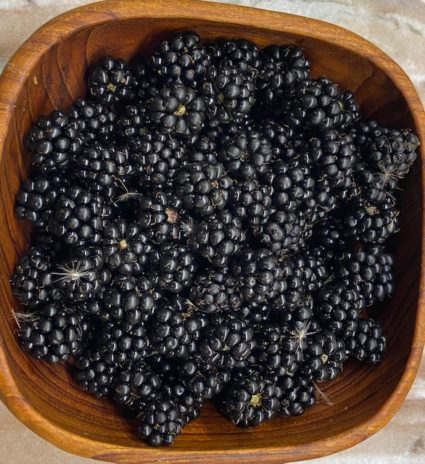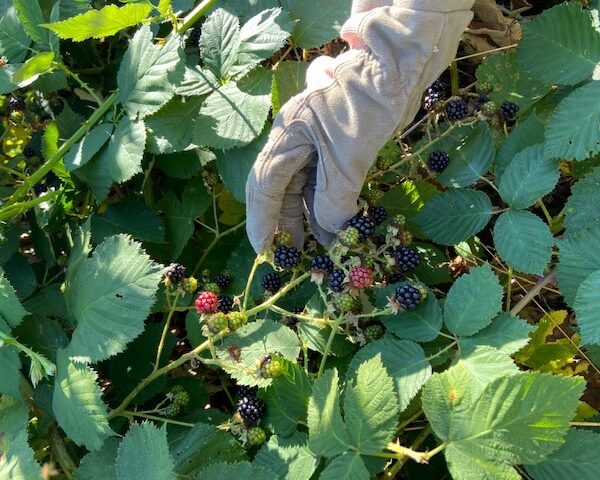They are sweet, tart, succulent and tangy. Summer on the tongue. The mighty blackberry: as big as your thumb; a deep, inky sheen with purple highlights; a nuanced flavor with earthy undertones and hints of Pinot Noir that lends itself equally to ice cream and balsamic vinegar, to muffins and salad greens. It is the height of season here in Oregon’s Willamette Valley, producer of 90 percent of all the blackberries you will find in the freezer section of your grocery store.
I should be rejoicing, my basket full, my lips stained purple, my kitchen the scene of jams and cobblers. I am not.
To me, blackberries are a noxious weed, a thorny, brambly, pernicious, injurious invader. I do battle with them every year, all year, not just during the height of the berry season. And every year, I lose. My arms above my elbow-high protective gloves, are scratched and scarred. The meadow in front of my house is rimmed with the invader; it will shrink by several feet by summer’s end if I don’t hack away at the near-impenetrable thicket. It is a strenuous task. They are not called blackberry “vines.” They are blackberry “canes,” fat, woody, solid, like a walking stick (if you wanted to lacerate your hands).
Related stories
Yardscaping as a metaphor for reporting and writing
Puns that make a point
Everyday J-school
Journalism lessons from crafting beer
But…here’s what I like about blackberries: They are persistent. They do not know when to quit. It doesn’t matter how much you curse at them, how violently you attack them with clippers, how close to the ground you lop off the canes — they keep coming back. Like me. Like all of us reporters, freelancers and authors, whose brilliant ideas get nixed, passed over, squashed. You pitch to your editor. You send a query. You write a proposal. And it’s nipped, lopped, discarded, rejected. But you come back with another. And another.
Here’s what else I like about blackberries: When things are going poorly inside, when I am standing clueless in front of my computer screen struggling to bring sense, order, structure — anything — to whatever I am working on, the encroaching perimeter of blackberries is out there, visible from my window, beckoning me with hours of distraction. Many years ago, before my blackberry life, I bought a vintage refrigerator, the kind with the little freezer box inside, just so I could lose myself defrosting it — a meditation with hot water and ice pick, procrastination with a purpose, a time-out when reportorial challenges threatened to overcome me.
But here’s the challenge: Hacking at blackberries to take a break from the rigors of writing can remind me too much of my craft. As I whack my way through the thicket, bloody but unbowed, I am presented with thorny insights, self-teaching moments big and small. I don’t always lose myself in the task, as I did defrosting that 1940s Crosley. Instead, I find myself ensnared in the writing issues that face me, that face all writers.
Superficial snipping isn’t enough
It is easy, for example, to view pruning as editing. And, taking a lesson from blackberries, it is easy to see how a snip here and there — superficial editing — does not get the job done. I wrote recently about the J-school lessons I had to unlearn to become the writer I wanted to be. One lesson I didn’t mention then was how I was taught to think about editing. I was taught to catch and remove blunders: misspellings, grammatical gaffs, errors of fact. This is important. And if you are time-strapped and can do no more, at least you’ve done this.
But that’s like taking a pair of hand clippers and snipping off a few errant shoots to get at a cluster of berries. That superficial pass often doesn’t get you much, either in the worlds of blackberry hacking or journalism, if what you’re after is a top, berry-producing plant or the most thorough, compelling story you can write. In fact, nipping just serves to reveal how much more pruning (editing) is needed if you want to get to the good stuff.
Out in the meadow, gloved and scarred, I think about these worlds together. I don’t just trim my blackberry thicket or neaten it up around the edges. I go big. I look at it with fresh eyes. It could be shapelier. It could be shorter. Maybe it doesn’t need to be at all. Rather than snipping, perhaps I need to get down on my knees, follow the thick, thorny cane down to the soil and yank it up by its root.
This is a radical act — appropriate given that “radical” comes from the Latin word for “root.” This is what revising (literally seeing again) a piece of writing is about, deep, to-the-roots reworking, a bold act that often does not feel good in the moment but yields great benefits upon reflection.
Editing is what I learned in J-school. Revising is what I taught myself.
What’s hidden in the thicket
Down on my knees, arms thrust into the thicket (wearing those mighty, to-the-elbow gloves), lopping off branches as I go, I come across what was hidden by the overgrowth: snowberry, elderberry, vine maple and, alas, poison oak. And I think: This is just what a strong, brave revision can do. It can reveal what you didn’t know was there in the story, what was obscured by too much information too soon, that unnecessary aside, that overly elaborate description, that quote that revealed far less than you thought it did. The more clutter you clear, the more clearly you see.

I tell myself this as a thorn grabs hold above my elbow, plucking the skin, and a thin trickle of blood snakes its way down into my glove.
Because I am out doing battle against the invader for hours at a time in all seasons, and because the work is not exactly mentally taxing, I am presented with long stretches of time to consider other thorny lessons. When I first starting writing, I thought that writing was the main and most important and most time-consuming part of, well, writing. I learned, as I took on bigger projects and, especially, as I came face-to-face with my own ignorance, that it wasn’t. Research and reporting are. Gathering the rich content that gives me the opportunity — and the challenge — to tell compelling stories: This is the most important work.
But all that reporting work does not effortlessly translate into a great story. Making sense of that research — and kneading, sculpting, massaging (I’m not sure what the verb would be) all my notes and recordings and images, all that information, those impressions, — this is the true challenge.
I think about this as I thwack away. The thicket that rims the meadow is a brambly arc that runs about 60 yards. This presents an overwhelming task, so overwhelming that it paralyzes action. Yet I have to take action.
This is so much like that moment — a very long, terrifying moment — when I face stacks of notes, a pile of books with tabbed-over pages, dozens of bookmarked sites, too many voice memos and hastily thumbed reminders, all the material that I need to somehow craft into a book that people will want to read. I have learned that I must do two things at once: Take the long view while also focusing on the detail. I need to see both the scope of what I have and the specifics, the global and the granular. Only then can I find a path through the research and reporting, and move to create a structure that will guide me as I write.
The blackberries tell me this. I stand back and evaluate the half-a-football-field length of work in front of me. I force myself to approach, to move in close to examine one small section at a time. How thick are the canes? Can I get to the roots? Do I start with nippers and move to pruners, or vice versa? I tell myself this will take a long time. I must be patient and persistent. I must prepare to be frustrated — and bloodied.
The parallels between this and my journalistic work are so, well, parallel.
And so is the result: A trimmed perimeter that looks more landscaped, less out of control. Curated research that takes the shape of an outline, a map. A bowlful of blackberries (I may hate the plant, but I love the fruit). A book in my hand.
Fun-fact postscript
The single most invasive blackberry is the Himalayan. It has pretty much choked out all the other varieties on my land. The Himalayan is not from the Himalayas. It is from Armenia, brought to North America by Luther Burbank, the plant wizard who created more than 800 species of fruits and vegetables. The Himalayan was not the man at his disciplined best.
***
Lauren Kessler’s two most recent books, “Grip of Time: When Prison is Your Life” and “Free: Two Years, Six Lives, and the Long Journey Home,” are deep dives into the worlds of incarceration and reentry. She continues to correspond with and edit the work of the men in the prison writing group she founded in 2016, and is mentoring two of the previously incarcerated men.



